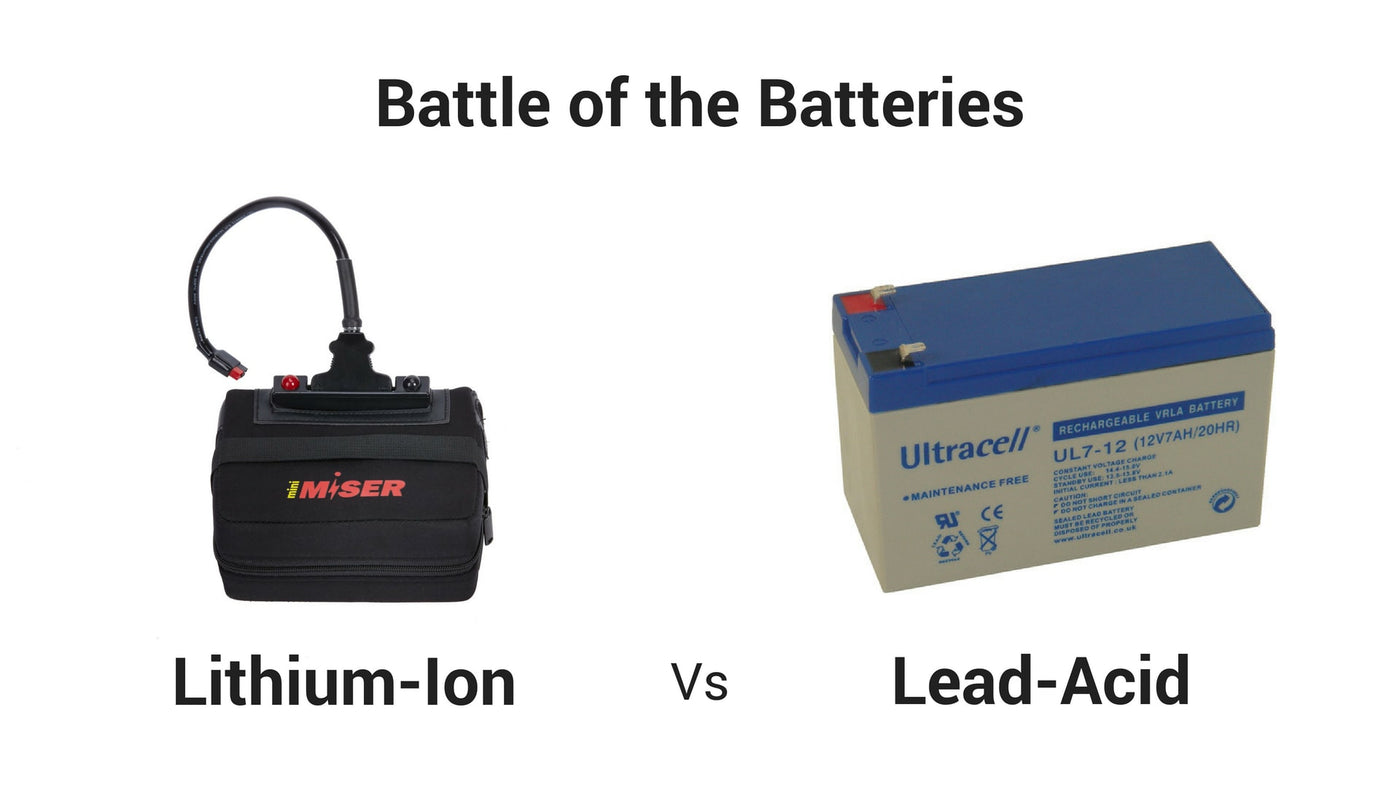Your Cart is Empty
Memorial Day Pre-Sale Now On! All Orders Include 3 Free Accessories of your choice and free shipping!
Memorial Day Pre-Sale Now On! All Orders Include 3 Free Accessories of your choice and free shipping!

When shopping for an electric golf caddy cart, the battery is one of the most important factors to consider.
There are two types of battery used on motorized golf push carts - the newer lithium-ion batteries and older lead-acid batteries. With the exception of cheaper electric trollies that offer the heavier and less efficient lead-acid batteries, most major golf caddy brands now only sell lithium-ion batteries.
Lead-acid batteries weigh around 25 lbs. and rarely last more than 18 holes on a single charge. They are much cheaper than lithium-ion batteries, but you'll end up paying more in the long run because they don't usually last more than 100 cycles before needing to be replaced. Lithium-ion batteries can last well over 500 charges if properly cared for.
Many factors, such as your bag's weight, how hilly a course is, the quality of the battery cells, amp hours, and voltage will all dictate how long the battery will last on a single charge.
The amp hours you see listed on battery specs refer to how long the caddy can deliver that power and how much power capacity they have, depending on the current being supplied. For example, a 1 amp hour battery should be able to continuously supply a 1 amp current to a load for 1 hour or a 2 amp current for half an hour.
Voltage is a measure of the difference in charge between negative and positive atoms. In theory, more voltage will equate to more power, but how efficient the battery is in applying that power depends on the relationship between volts and amp hours.
After years of testing, QOD's manufacturer found the perfect combination of amp hours to voltage which allows the QOD to last 36 holes on a single charge. The QOD's 18aH, 14.4V battery weighs just 5 lbs. However just because another battery may have similar specs does not mean it too will last 36 holes since this is all dependent upon the caddy's size, weight, and efficiency of power usage.
With the exception of cheaper electric golf caddies that offer the heavier and less efficient lead-acid batteries, most major electric golf push cart brands now only sell lithium-ion batteries. However, that wasn't always the case.
Growing up in the U.K., electric golf caddies – or electric trollies as we called them, were a lot more common than they are in the U.S. At my home club, everyone walked and at least 75% of members over the age of 30 owned an electric golf push cart.
When one of my golfing buddies decided to shell out a few hundred on a brand new Powakaddy, you can imagine my excitement to try it out. I won’t deny I was initially impressed, but it soon became apparent the battery was about as reliant as my short game (get it within 20 feet and two-putt is usually my goal around the greens).
For one, the thing weighed about 25 lbs and often died around the 16th hole, meaning my friend had to manually drag what must have felt like the equivalent of a small child behind him for the last two holes – once you account for the additional weight of the cart and bag. Maybe some parents who have taken their kid shopping can relate.
For another, he was constantly shelling out an extra $100 or so every 6-12 months for a new battery as it would simply stop charging. Seeing my friend’s struggles first hand made me reluctant to buy until I started talking to other members of my club and realized there was a better solution – a lightweight lithium-ion battery.
Relatively new to the market at the time, these batteries were not only five times lighter than the lead-acid ones like my buddy had, but also lasted at least 27 holes on a single charge and had enough charging cycles to go five years or more (over 500) without needing replacing.
The only downside? They were three-times more expensive. However, given the huge advantages over lead-acid batteries, it wasn’t even close to being an even contest. The lithium-ion could have cost six-times more and I still would have got one. When I pointed out the effort and money my friend had put into lead-acid batteries over the previous years, he agreed that swapping to a lithium-ion battery was a no-brainer.
The battery's longevity was particularly important for me as I was a golf-obsessed nut who would regularly play 36 holes in a single day. The QOD's lithium-ion battery comfortably did, and still does that job.
There's little doubt that lithium-ion batteries are now the leader in the electric golf caddy industry, but a couple of companies still try and draw you in with the cheaper prices that come with selling a trolley with a lead-acid battery. My advice – don’t get drawn in by the cheap upfront price. These things are notorious for being heavy and unreliable. You will almost certainly end up enjoying your rounds less and paying more in the long run.
Comments will be approved before showing up.
Eric Schurr
February 18, 2019
Excellent summary and analysis. Very helpful.